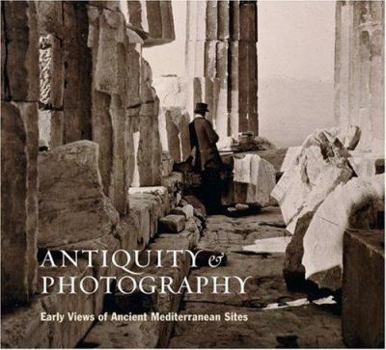Antiquity and Photography: Early Views of Ancient Mediterranean Sites
Following the invention of the daguerreotype and calotype processes in 1839, views of ruins, classical statuary, and the antiquities of the Mediterranean and the Orient were among the first images produced by pioneer photographers. The unique accuracy and immediacy of photographs fundamentally changed aesthetic and scholarly approaches to the artifacts of the past.
This groundbreaking book explores the intellectual underpinnings of the relationship between antiquity and photography in the period 1840-1880. Drawing on the extensive collections of the Getty Museum and the Getty Research Institute, this richly illustrated volume presents an introduction to the subject, followed by a detailed discussion of the influence of photography on archaeology, an analysis of the ways antiquity is depicted, and biographical studies of two major photographers, Joseph-Philibert Girault de Prangey and William James Stillman. Portfolios of works by Maxime Du Camp, John B. Greene, Francis Frith, Robert Macpherson, Adolphe Braun, and others appear between the essays.
This groundbreaking book explores the intellectual underpinnings of the relationship between antiquity and photography in the period 1840-1880. Drawing on the extensive collections of the Getty Museum and the Getty Research Institute, this richly illustrated volume presents an introduction to the subject, followed by a detailed discussion of the influence of photography on archaeology, an analysis of the ways antiquity is depicted, and biographical studies of two major photographers, Joseph-Philibert Girault de Prangey and William James Stillman. Portfolios of works by Maxime Du Camp, John B. Greene, Francis Frith, Robert Macpherson, Adolphe Braun, and others appear between the essays.
Format:Hardcover
Language:English
ISBN:0892368055
ISBN13:9780892368051
Release Date:November 2005
Publisher:J. Paul Getty Museum
Length:240 Pages
Weight:4.10 lbs.
Dimensions:1.1" x 11.4" x 10.3"
Customer Reviews
2 ratings
Beautiful reproductions of early photographs
Published by Thriftbooks.com User , 18 years ago
Soon after Daguerre demonstrated his photographic process in Paris in 1839, the new technology was used to capture in two dimensions the ruins of antiquity. Photography and archaeology, in fact, developed as disciplines more or less hand-in-hand. In this digital world, it is particularly interesting to be reminded of the effort that went into taking a single photograph at the time--the medium's pioneers traveling by sea and traipsing across Egypt or Greece or Italy lugging their easily damaged photographic equipment, the long exposure times required by then state-of-the-art cameras. More than a hundred of these early photographs, from roughly the first forty years of the medium's history, are beautifully reproduced in Antiquity & Photography: Early Views of Ancient Mediterranean Sites, published by the J. Paul Getty Museum. (The photographs included are taken from the Getty Museum's Department of Photography and the Research Library of the Getty Research Institute.) Andrew Szegedy-Maszak of Wesleyan University (whom I have to thank for my copy of the book) provides the book's introduction, a survey of early photographic activity in Egypt, Greece, and Italy, and he has also contributed one of the book's four essays, "An American on the Acropolis: William James Stillman." Stillman was an amateur archaeologist who published a collection of photographs of the Acropolis in 1870. Lindsey Stewart ("In Perfect Order: Antiquity in the Daguerreotypes of Joseph-Philibert Girault de Prangey") writes about another amateur, Girault de Prangey, who made daguerreotypes throughout the Mediterranean in the middle of the century. In her essay "The Art and Science of Antiquity in Nineteenth-Century Photography" Claire Lyons writes about the use of photography by early archaeologists. The new technology allowed archaeologists to document their finds, and "facilitated a systematic reading of buildings literally as texts in stone, legible across their facades." And John Papadopoulos focuses on Athens in his contribution, "Antiquity Depicted," in which he demonstrates "how images negotiate between expectations, reality, and the ideal." Debra Hamel -- author of Trying Neaira: The True Story of a Courtesan's Scandalous Life in Ancient Greece (Yale University Press, 2003)
Magnificent and Moving
Published by Thriftbooks.com User , 18 years ago
Magnificents are the monuments and buildings that appears in the photos, magnificents are the photos themselves as a token of the excellency of the technique even in so an early epoch and, at last, there is also sad magnificence in the daring and refined spirit of the first men that make use of the new tool to document the past. Looking at these photos as objets of combined antiquity you cannot but think in the people that took them, now they also antiquities in the history of photography, many of them forgotten, his memories dusty and crumbled. Magnificent, finally, the book in itself. A must for any art lover and history buff.





